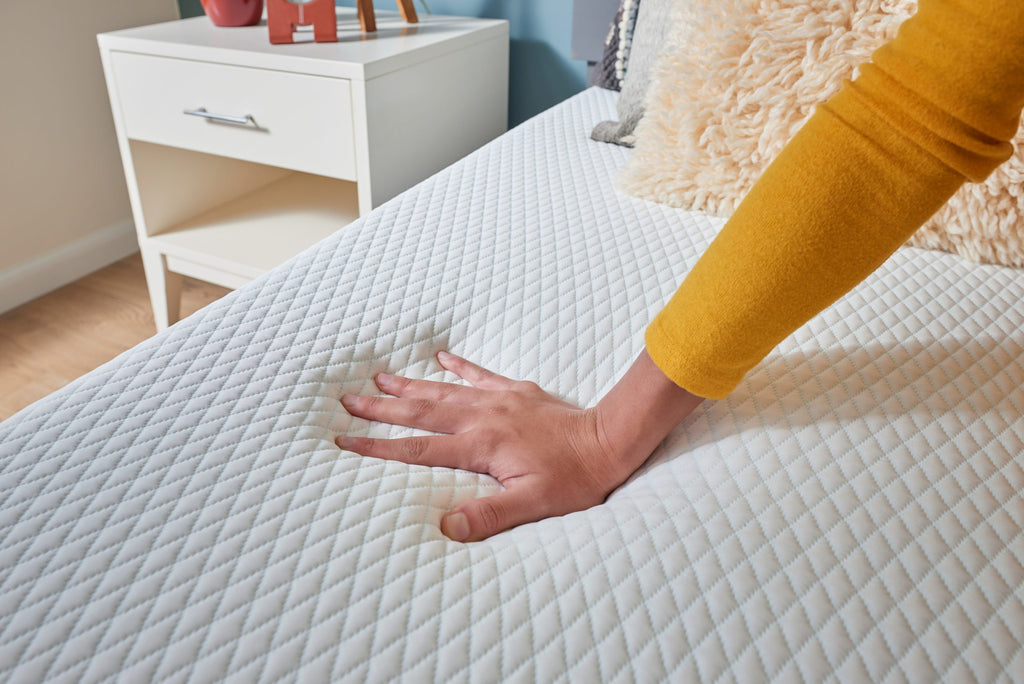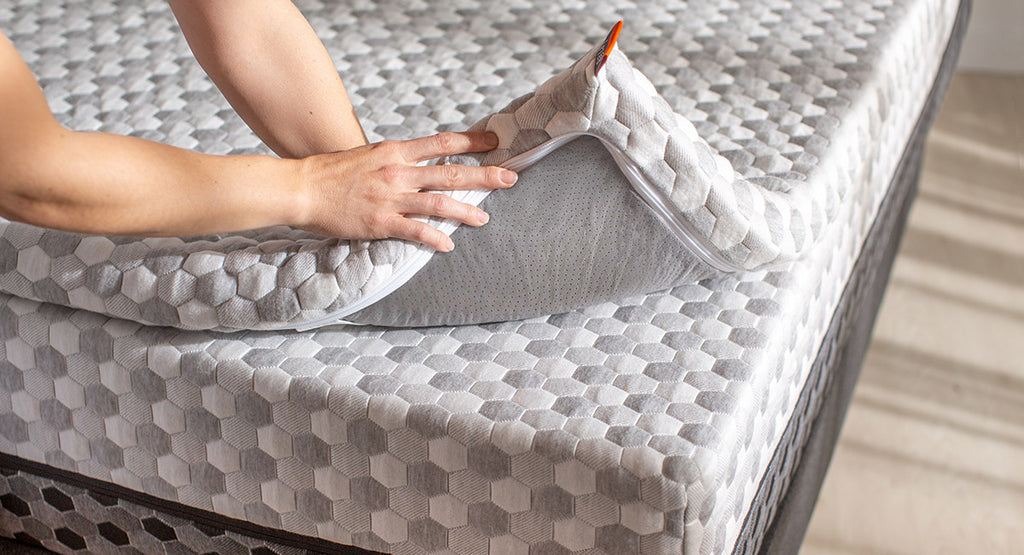When it comes to ensuring a good night's sleep, having a clean mattress topper is essential. Over time, mattress toppers can accumulate stains, dirt, and bacteria that may affect your sleep quality and overall health. In this guide, we will explore the best methods for cleaning different types of mattress toppers to help you maintain a fresh and hygienic sleeping environment.
- Regular maintenance: To prevent your mattress topper from becoming too dirty, it is important to regularly maintain it by vacuuming it with a hand-held vacuum or using a lint roller to remove surface debris and dust. This should be done at least once a month.
- Spot cleaning: If you notice any stains on your mattress topper, it is important to address them promptly. For liquid stains, gently blot the area with a clean cloth and a mixture of water and mild detergent. Avoid using too much water as it can cause the mattress topper to become moldy. For oil-based stains, sprinkle some baking soda on the affected area and let it sit for a few hours before gently brushing it off.
- Machine washing: If your mattress topper is machine washable, you can clean it in a front-loading washing machine on a gentle cycle with a mild detergent. Make sure to check the care label on your mattress topper for specific washing instructions. Once washed, hang it to air dry or tumble dry on low heat.
- Hand washing: For mattress toppers that are not machine washable, you can hand wash them in a bathtub or large sink with lukewarm water and mild detergent. Gently agitate the mattress topper and rinse thoroughly with clean water. Squeeze out excess water and hang it to air dry.
- Deodorizing: To eliminate any odors from your mattress topper, sprinkle baking soda over the surface and let it sit for a few hours before vacuuming it off. You can also use essential oils or fabric refresher spray to freshen up the mattress pad.
- Sunning: If your mattress topper is made of natural materials like wool or cotton, you can benefit from sunning it occasionally. Simply place the mattress topper outside in direct sunlight for a few hours to help kill bacteria and freshen it up naturally.
By following these cleaning methods, you can ensure that your mattress topper remains clean, hygienic, and free of allergens, allowing you to enjoy a restful night's sleep every night. Remember to check the care instructions provided by the manufacturer before attempting to clean your topper to avoid damaging it.
How to Identify Stains on Your Mattress Topper

Before diving into the cleaning process, it's crucial to identify any stains on your mattress topper. Common stains found on mattress toppers include spills, sweat stains, and dust accumulation. Methods to detect stains on memory foam toppers may vary due to the material's unique properties. Using baking soda can help you identify hidden stains that are not visible to the naked eye.
- Stains Found on Mattress Toppers: Stains on mattress toppers can be caused by various factors such as food or drink spills, pet accidents, or body oils. These stains not only affect the appearance of your topper but can also lead to unpleasant odor and bacterial growth.
- Methods to Detect Stains on Memory Foam Toppers: Memory foam mattress toppers are known for their ability to conform to the body and provide superior comfort. However, detecting stains on memory foam can be challenging as the material absorbs liquids quickly. A thorough inspection and the use of specialized cleaning may be required.
- Using Baking Soda to Identify Hidden Stains: Baking soda is a versatile cleaning agent that can help reveal hidden stains on your mattress protector. Simply sprinkle baking soda over the surface, allow it to sit for a few hours, then vacuum it off. The baking soda will absorb moisture and odor, making stains more visible for targeted cleaning.
Methods for Cleaning a Memory Foam Mattress Topper

When it comes to clean a foam mattress topper, it's essential to choose the right cleaning method based on the type of stain and topper material. Spot cleaning with a mild detergent and water is suitable for minor stains, while machine washing may be necessary for more extensive cleaning.
Spot Cleaning vs. Machine Washing
It involves targeting specific areas of the mattress pad with a gentle cleaning solution to remove stains. On the other hand, machine washing the topper provides a more thorough cleaning but requires careful handling to prevent damage to the foam.
Choosing the Right Cleaning Solution for Your Topper
When selecting, opt for mild, non-toxic cleaners that are safe for the material. Harsh chemicals can damage the foam and affect its performance and longevity. Follow the manufacturer's guidelines for best results.
Deep Cleaning Techniques for Stubborn Stains
For stubborn stains that are difficult to remove, deep cleaning techniques such as steam cleaning or enzyme-based cleaners may be effective. These methods can penetrate deep into the foam to lift tough stains and eliminate odor-causing bacteria.
Washing Machine Tips for Mattress Toppers

While some mattress toppers are machine washable, it's essential to understand the pros and cons of using a washing machine for cleaning. Proper precautions should be taken to ensure the topper is not damaged during the washing process.
Pros and Cons of Washing Your Topper in the Machine
Washing your mattress topper in the machine can save time and effort, especially for larger toppers. However, the agitation and heat from the machine may damage delicate foam materials, leading to deformation or decreased comfort.
Precautions to Take When Using a Washing Machine
If you decide to machine wash your topper, use a gentle cycle with cold water and mild detergent. Avoid using bleach or strong cleaning agents that can harm the foam. Always check the manufacturer's instructions before washing your topper.
Guidelines for Machine Washable Mattress Toppers
If your mattress topper is machine washable, follow the recommended guidelines for cleaning. Use a front-loading washer, if possible, to minimize friction and ensure even distribution of water and detergent. Allow the topper to air dry completely before reusing it.
Alternative Cleaning Methods for Mattress Toppers

Aside from traditional cleaning techniques, there are alternative methods to maintain and prolong the lifespan of your mattress protector. Regular vacuuming, using mattress protectors, and cleaning can help keep your topper fresh and free of stains.
Using Vacuum Cleaners to Maintain Your Topper
Regular vacuuming of your mattress topper can help remove dust, debris, and allergens that accumulate over time. Use a vacuum cleaner with a soft brush attachment to gently clean the surface and crevices of the topper without causing damage.
Utilizing Mattress Protectors to Extend Topper Lifespan
A mattress protector acts as a barrier between your mattress topper and external factors such as spills, dust mites, and allergens. Investing in a high-quality mattress protector can prevent stains and prolong the lifespan of your topper.
Spot Cleaning Techniques for Quick Maintenance
For quick maintenance between deep cleanings, it can help address minor stains and spills promptly. Use a damp cloth with mild soap to gently dab at the stain without saturating the foam. Allow the area to air dry thoroughly before using the topper.
Tips for Choosing and Maintaining a Mattress Topper

When selecting a new mattress topper, consider factors such as material, thickness, and comfort level to suit your sleeping preferences. Establishing a regular cleaning schedule and implementing stain prevention methods can help prolong the lifespan of your topper.
- Factors to Consider When Selecting a New Topper: Whether you prefer a memory foam, latex mattress topper, or down alternative topper, assess your comfort needs and budget before making a purchase. Ensure the topper is compatible with your mattress size and offers the right level of support for a restful night's sleep.
- Regular Cleaning Schedule to Keep Your Topper Fresh: Create a routine cleaning schedule for your mattress topper to prevent the buildup of stains and odors. A weekly vacuuming and cleaning as needed can help maintain a clean and hygienic sleeping environment.
- Stain Prevention Methods for Prolonging Topper Lifespan: To prevent stains and damage to your topper, consider using a mattress protector or cover to shield it from spills and allergens. Avoid eating or drinking in bed and address spills promptly to minimize the risk of permanent stains.
FAQ's
How do I clean a mattress topper?
To clean your mattress topper, start by vacuuming it to remove any debris. Then, clean any stains with a mild detergent and water solution. You can wash the mattress topper according the manufacturer's instructions.
Can I wash a mattress topper in the washing machine?
Yes, you can wash some types of mattress toppers in the washing machine. However, always check the care label on your specific mattress topper for washing instructions.
How do I remove stains from my mattress topper?
To remove stains from your mattress topper, you can clean using a mixture of water and mild detergent. For tough stains, consider using a mattress stain remover following the product's directions.
Do I need to dry a mattress topper after cleaning?
Yes, it is essential to allow your topper to dry completely after cleaning to prevent mildew and odors. You can air dry it outdoors or follow the drying instructions provided by the manufacturer.
How often should I clean my mattress topper?
It is recommended to clean your mattress topper every few months or as needed, especially if you notice any stains or odors. Regular cleaning can help prolong the life of your topper.
Can I wash a memory foam mattress topper?
While some memory foam mattress toppers are washable, it is generally not recommended to wash them in a machine as it can damage the foam. Instead, clean such toppers using a mild detergent and water solution.
What is the best way to keep my mattress topper clean?
To keep your topper clean, regularly vacuum the surface, clean stains promptly, and allow it to air out occasionally. Using a mattress protector can also help prevent stains and spills.

